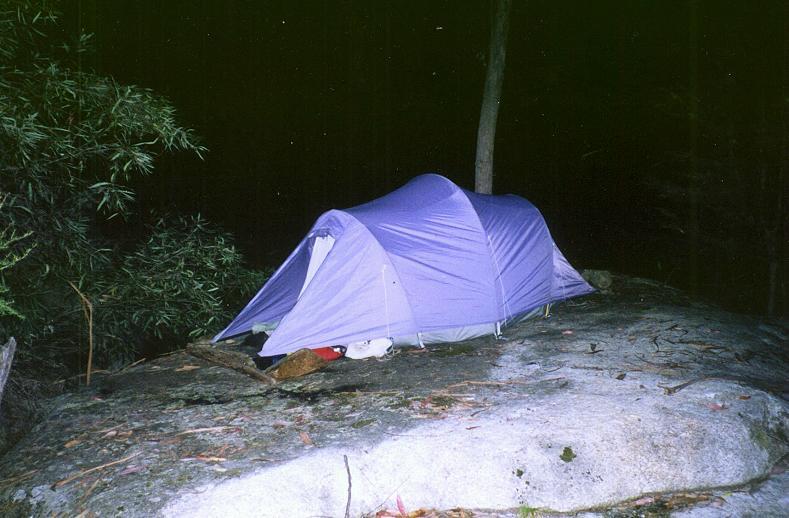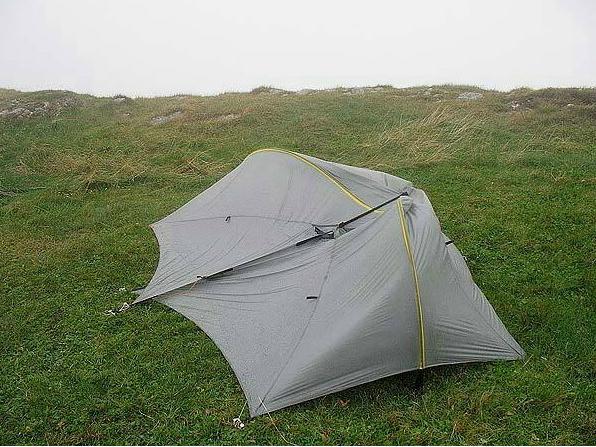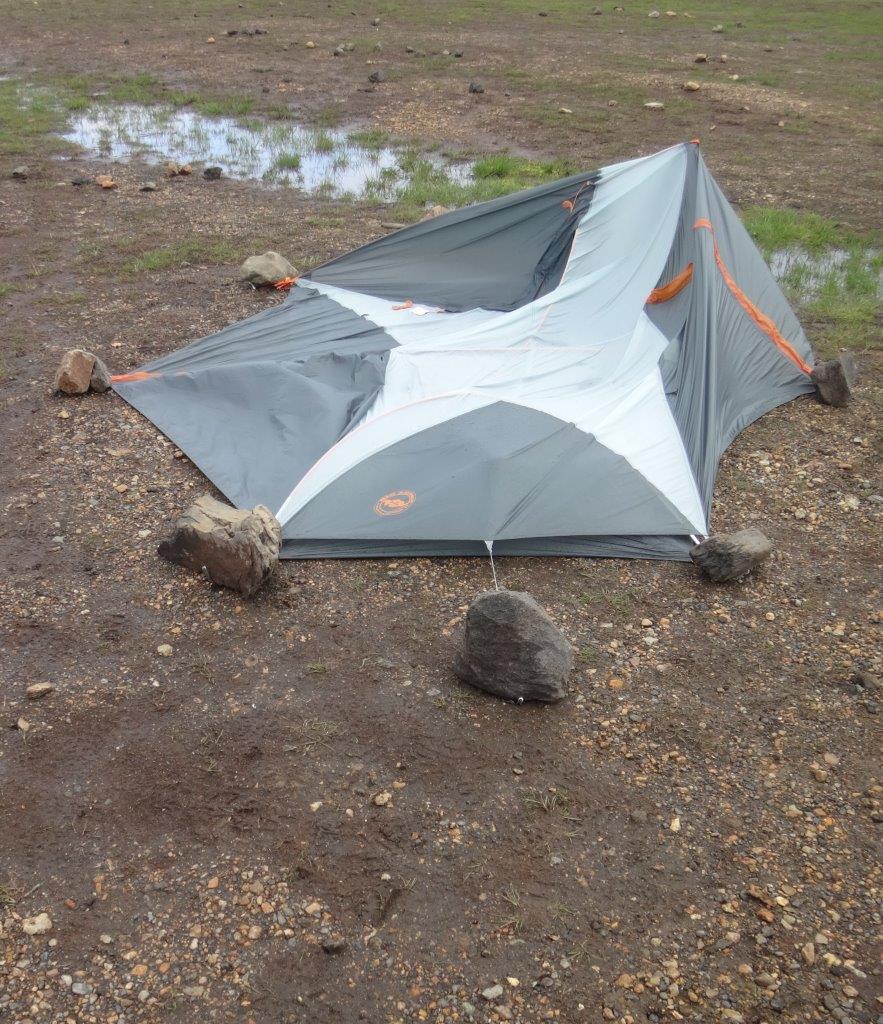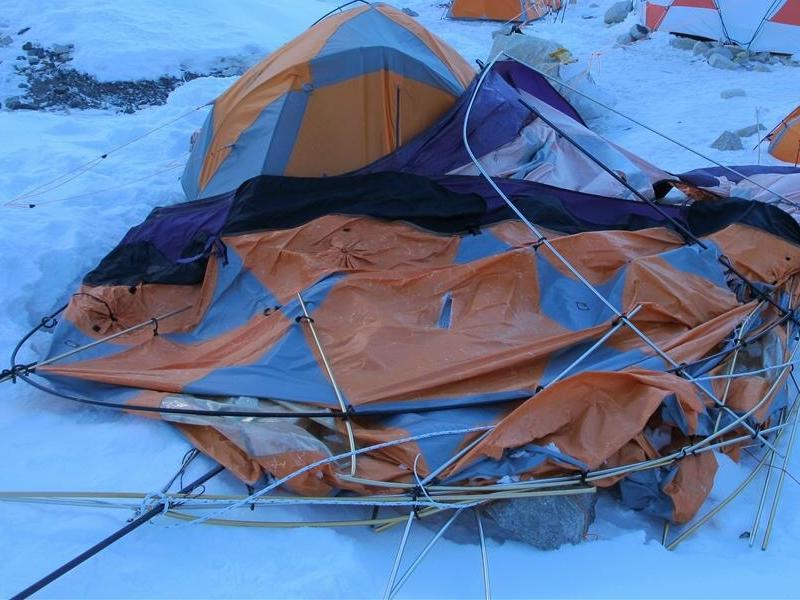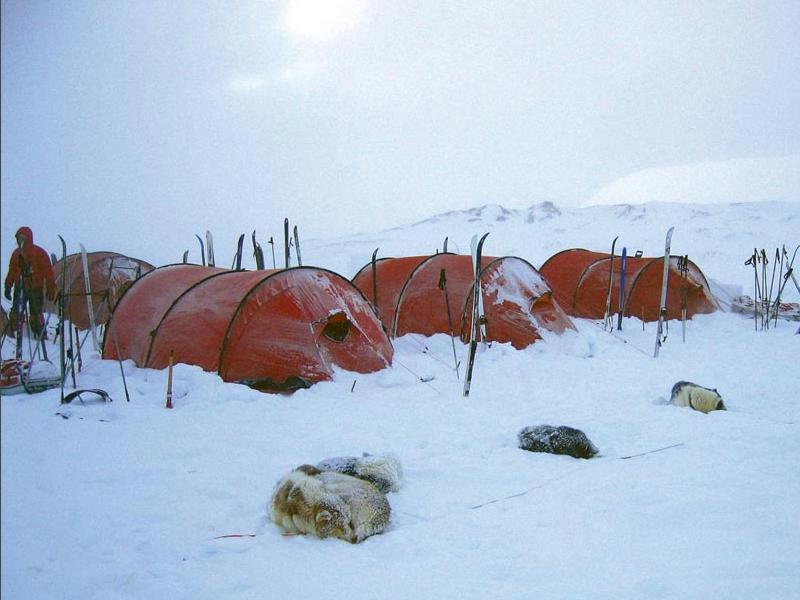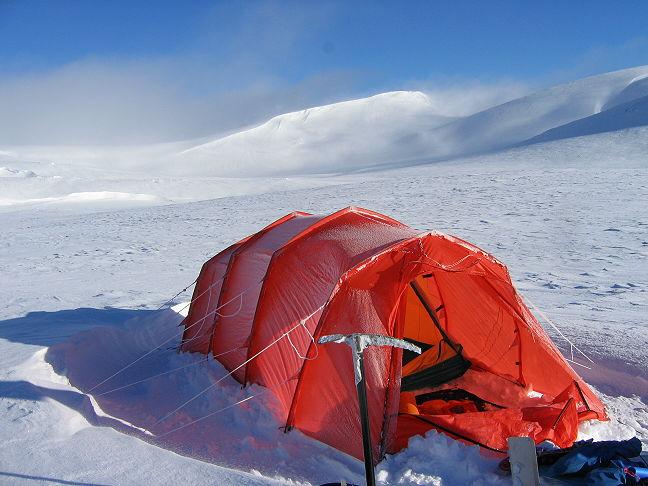Topic
Freestanding > Non-Freestanding Tents??
Forum Posting
A Membership is required to post in the forums. Login or become a member to post in the member forums!
Home › Forums › Gear Forums › Gear (General) › Freestanding > Non-Freestanding Tents??
- This topic has 98 replies, 15 voices, and was last updated 4 years, 5 months ago by
 Roger Caffin.
Roger Caffin.
-
AuthorPosts
-
Sep 23, 2020 at 2:48 pm #3677199
Below treeline I always use a non freestanding tent. Camping above treeline or in the snow, I prefer a freestanding option.
Odd. I would have expected the opposite.
Especially in a howling snowstorm.Cheers
Sep 23, 2020 at 4:27 pm #3677211Odd. I would have expected the opposite.
Especially in a howling snowstorm.As was once said, “experience can be long, but narrow.” I think your statement perfectly reflects the truth of this observation.
Sep 23, 2020 at 4:32 pm #3677212Um … I am not sure what that means. Can you explain?

Cheers
Sep 23, 2020 at 5:17 pm #3677219Roger,
I think the preference for free-standing tents above treeline is because: 1) The better ones place less stress on the pegs; and 2) Above treeline the ground may be less suitable for pegs, so less reliance on them makes sense. That assumes there is ground, not deep snow under foot.
The second comment I think suggests you may be narrow minded. Guess what. All humans are narrow minded. See the current PBS series, ‘Hacking the Mind.’ So it suggests that you are human. I think we knew that. The real question is when we are all long gone, and if evolution is still working, will people still be narrow minded? And the answer is just one of the many things we must live without ever knowing.
Sep 23, 2020 at 5:33 pm #3677221Um … I am not sure what that means. Can you explain?
It’s obvious your experience is geographically limited… long experience, but shallow. There are many windier and more severe areas than your experience encompasses.
Sep 23, 2020 at 6:20 pm #3677227There are YouTube videos of the 2-pole BD FirstLight enduring winds of 60+ mph/96 kph overnight at altitude (1 2), and there are many more of similar freestanding tents.
I hate having to pitch a non-freestanding tent in conditions like this, and rely 100% on tie-outs for it to remain pitched. I’ve done it enough that it’s one of the specific reasons, among others, that I long ago chose a freestanding tent for alpine conditions. If there are some solid trees to tie into I would consider a non-freestanding tent in these conditions.
Sep 23, 2020 at 6:47 pm #3677232There are YouTube videos of the 2-pole BD FirstLight enduring winds of 60+ mph
I used the BD Firstlight for a number of years here, and occasionally in winds well over 60mph above timberline. It worked well, but in those conditions a geodesic freestanding similar to my old NF VE24 would be my first choice.
Sep 23, 2020 at 6:50 pm #3677234@bradmacmt: +1
Sep 23, 2020 at 8:29 pm #3677244“David U: What free-standing tent do you use above treeline and/or in exposed (wind) locations?”
Hopefully I don’t get slammed for this but either a Hilleberg Niak or a Hilleberg Soulo (if in winter months). The Niak will handle shoulder season snow with not problem and both are extremely wind worthy at least in my experience.
To Brad’s point, I think a lot of one’s preference is based on where they trek. Hard packed ground or rock above treeline in the Rockies makes me prefer a good freestanding option. You still have to peg it down but the structure of the shelter isn’t predicated fully on whether a peg holds. You can hold the guylines down with rocks (or tie them to large rocks). Been there, done that. YMMV.
Sep 23, 2020 at 8:37 pm #3677245I had seen YouTube video #2 before. It shook badly all night, had solid guy ropes trying to support it, and ended up with bent poles in the morning. Not what I would want for a multi-day trip, and not ‘free-standing’. The guys inside it that night were not especially happy either.
I find pitching my non-free-standing tunnel under gale conditions quite easy, and I have done it a number of times. In the snow there are no problems at all if you have snow pegs.
On sheet granite – yeah, there could be a few difficulties. I try to avoid walking into those sorts of difficulties. With granite here in Oz I can usually find a soil patch: granite does break down into soil quite quickly.
HYOH, PYOT
Cheers
Sep 24, 2020 at 9:13 am #3677284If you “prefer” freestanding above tree line…why “prefer” non freestanding below?
Hiking in the Sierra, you’re very frequently pitching on granite or very shallow soil above tree line. There are also tons of rocks around, so you use those for anchors. Very solid.
I’d also prefer a non freestanding tent above treeline in a gale. I do my best not to be out in those conditions. True, I don’t hike in Australia or the Lake District, since I live on the west coast of the states. I’m narrow like that, having a home.
Sep 24, 2020 at 12:52 pm #3677302I thought I was clearer on that. Below treeline I use a 1lb (ish) non freestanding shelter because a.) the ground is softer and b.) there is more natural windbreaks available. Where I trek, above treeline there is fewer opportunities for softer soil. As I mention above, I still guyout my freestanding tent with rocks but I don’t use pegs. What I like about this set up is that should a guyline pull lose, the inherent structure of the shelter remains. It will also do much better with wet snow.
And yes, I have used non freestanding shelters above treeline (been doing this for 25 years) but PREFER my current set up. I most certainly am not implying that it can’t or shouldn’t be done the opposite way.
Cheers,
Sep 24, 2020 at 1:22 pm #3677304I thought I was clearer on that.
apologies, I hadn’t had my coffee when I posted. Yes, of course non freestanding below tree line; free standing above is what I would prefer as well.
Sep 24, 2020 at 2:37 pm #3677311Oh…lol. No worries – just wanted to make sure I made sense.
Sep 24, 2020 at 3:33 pm #3677316There are times when one has no choice.

Long, steep, extremely rocky granite ‘gully’ below a big waterfall, more boulders than rocks, and we started down in the middle of the day. After all, there has got to be somewhere to bivy, yes?
The boulders got bigger and the sides of the gully steeper. Travel was a lot slower than expected. It was getting dim if not dark, and there had been strictly zero possibilities for the last hour, when we came across this boulder. The back end of the site under the tent was a bit tilted, but only in the vestibule area. Finding large sticks or small logs to hold the guy ropes was not a problem; finding rocks small enough that I could pick up was! But dinner was good.
Cheers
Sep 24, 2020 at 3:48 pm #3677324We all live in a small space and our experience, and therefore conclusions, shouldn’t be assumed to be universal. I’ve been from Nepal to Norway, Austria to Maine, Montana to Alaska. For me, I’ve seen and done enough to prefer a stoutly constructed freestanding tent in extreme conditions. There are essentially NO non-freestanding tents to be found on Himalayan climbs. Just a thought…
Sep 24, 2020 at 4:21 pm #3677329“You still have to peg it down but the structure of the shelter isn’t predicated fully on whether a peg holds.’ & “What I like about this set up is that should a guyline pull lose, the inherent structure of the shelter remains.”
David, thank you for expressing that so well, and better than I have been able to.
Roger, granted, there are the flat rock slabs. Any number of situations could force one to camp on one, and I’m glad you found the essential rocks to use as anchors. Australia has for several years held the record for highest recorded wind speed, surpassing the previous record on Mt. Washington. With all the summiting going on at Everest, and in the Kush, I’ve wondered why the windspeed record has not been broken once again. Even here, at little Chocorua, there was once a hotel above the treeline. Eventually, it was blown off the mountain. The small hikers’ cabin that replaced it has mammoth size chains running right over it in several directions, and secured with huge eye bolts in holes drilled into the rock. Very popular stop for hikers. Must have passed it dozens of times, but never stayed overnight. Like to sleep soundly.
Sep 24, 2020 at 5:54 pm #3677351I dunno – those chains look a bit slack to me. :)
Cheers
Sep 24, 2020 at 11:48 pm #3677389A couple of years ago David Thomas invited me to “Home of the Winds” Adak Island in the Aleutians about 1,000 miles west of Anchorage. When I asked if it got cold he said no, but the winds varied from 0-126 mph! I wonder if there is any fabric camping tent of any kind anywhere, regardless of weight, that can deal with that. Fortunately we didn’t have to.
Sep 25, 2020 at 1:33 am #3677391There is a thread on windspeed at
https://backpackinglight.com/forums/topic/83877/I wonder if there is any fabric camping tent of any kind anywhere, regardless of weight, that can deal with that [126 mph].
That is going to depend on several factors:
1) the design (shape) of the tent
2) the tensile strength of the fabric
3) the quality and lengths of the poles
4) the security and number of anchor points (ir pegs)If what you have is a tall pop-up with a big unsupported fabric span facing into the wind, the tent will collapse fairly soon. These sorts of tents are just not made for these conditions. (Ack to photogs who posted these)

The same applies to a number of similar designs with long poles and a lack of good guys.

It is relevant to note here that the height of the tent (part of ‘design’) does matter. The windspeed right at ground level is close to zero, rising as you go up. (I have a graph somewhere …)
What this means is that you need a tent which is going to slipstream the wind rather than try to oppose it full-on. To be sure, if you have lots of thick poles, a geodesic design can be quite robust, but it will be heavy. And it can collapse, making a big mess of bent poles.

Those who expect to camp in bleak and windy places usually use a tunnel tent. They have short fabric spans, short pole spans, and are well suited.

This is a group of Keron3 tents, in poor weather. The occupants don’t seem very fussed. I wouldn’t be either. They are good tunnels.

This is my 4-pole winter tent, taking 100 kph winds for two nights running without distress. But you may have seen this morning photo before. Why did we camp here? Well, the night before this visibility was under 2 m: we could see our feet, but poorly, and we knew there was no shelter anywhere nearby. So … we camped. For the record, that red tent weighs 2,200 g including the poles and 400 g of titanium snow pegs. The fabric itself is 1430 g.
Could it take winds of 200 kph (126 mph)? Dunno. I would want to sink it into the snow a bit (as far as I could, in other words), to get it below the worst of the wind.Cheers from the tunnel dweller
Sep 25, 2020 at 8:49 am #3677404That TT Rainbow isn’t freestanding.
Having said that, it is also not guyed out properly – there are guyout points along the pole sleeve and the apex of the cross pole. Note sure that would have made a difference.
That BA tent has the same issue as above – I don’t see any additional guyout point.
The third pic made me chuckle – that tent is crushed yet all of the freestanding tents behind it are sitting just fine.
Unless guyed out, any tent can incur failure:
“Vango Tunnel tents – never again
Aug 29, 2009#1
I have always liked the idea of tunnel tents with a large front vestibule to do your cooking in and a few months ago invested in a Vango Spirit 300. Not cheap at £320 RRP, but billed as a relatively serious tent “reassuringly confident in all conditions”. I took on a canoe-camping trip to Loch Shiel and it did well (very calm weather). At the back-end of last week I took it to the Lakes for an over-night back-pack, pitched it on brilliant if somewhat breezy spot by a tarn at about 2000ft and settled down for the evening. By dusk the wind had veered and strengthened and when it was fully dark the tent started distorting seriously, flattening to the ground despite all the extra guys and tension bands. I realised about 11pm that two of the three poles had bent and were providing no support at all, and spent the whole of the night until first light holding the last pole up to stop the tent completely collapsing. The geodesic tent near to me survived the night unscathed. Mercifully, although raining heavily all night it was also fairly warm, or I could have been in a pretty serious situation.”; )
Sep 25, 2020 at 3:37 pm #3677436Well, Vango seems to have gone a bit family camping these days. Their tunnels were only 2-pole affairs – OK if the tail is pointed into the wind, but not so good if the wind moves around to sideways. They were aimed at the Duke of Edinburgh market, which is not really a serious one. We did review the Tempest 200 in 2011.
Even so, I have to wonder how well the Spirit had been pitched. But again, only 2-pole.
Cheers
Sep 26, 2020 at 1:40 am #3677496From Vango’s page for the Spirit 300+ – date uncertain (weight has been added):
“Powerlite Alloy poles 7001-T6 alloy light, flexible and durable”
Suggest the T6 (#6 temper) may be the reason for the pole collapse. Have no trouble bending T6 with a Ridgid ratchet bender, and would never use it for a hooped tent pole.
Congrats on ID-ing the TT Rainbow. Darned if I can make it out. If it is a Rainbow, the pole would be Easton 340, with a T9 temper. Very strong. So I think David is right about the absence of guyouts being the weak point.
As for the Big Agnes; named after a nice mountain in CO, but the tents should be limited to campgrounds or well protected areas, and not for a fair comparison of free-standing to tunnel tents.
Wonder how many of these pics Roger has stashed away.
Sep 26, 2020 at 3:03 pm #3677548Wonder how many of these pics Roger has stashed away.
A few … -
AuthorPosts
- You must be logged in to reply to this topic.
Forum Posting
A Membership is required to post in the forums. Login or become a member to post in the member forums!
Trail Days Online! 2025 is this week:
Thursday, February 27 through Saturday, March 1 - Registration is Free.
Our Community Posts are Moderated
Backpacking Light community posts are moderated and here to foster helpful and positive discussions about lightweight backpacking. Please be mindful of our values and boundaries and review our Community Guidelines prior to posting.
Get the Newsletter
Gear Research & Discovery Tools
- Browse our curated Gear Shop
- See the latest Gear Deals and Sales
- Our Recommendations
- Search for Gear on Sale with the Gear Finder
- Used Gear Swap
- Member Gear Reviews and BPL Gear Review Articles
- Browse by Gear Type or Brand.


